|
Space Stations, Past and Future
Salyut 1 to 7
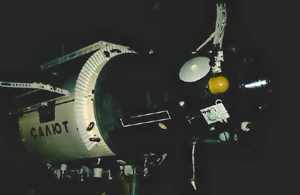 The first space station, Salyut 1, was launched by the Soviet Union - now Russia - on 19 April, 1971. It remained in orbit until 11 October that year. Five more Salyut craft were launched, and one failed to reach orbit over the following eleven years. Many space endurance records were set up by crews aboard the Salyut space stations. Little information was revealed about the purpose or work of them, however, but they made major contributions to our understanding of the effects of prolonged spaceflight on human beings. Additionally, many EVA techniques were developed and refined, so that walking in space became routine by the end of the Salyut era in 1985. As with the Skylab (see below), the re-entry of these enormous craft into the Earth's atmosphere caused problems for those below. Fortunately no-one was hurt, but minor property damage did result on occasions. The first space station, Salyut 1, was launched by the Soviet Union - now Russia - on 19 April, 1971. It remained in orbit until 11 October that year. Five more Salyut craft were launched, and one failed to reach orbit over the following eleven years. Many space endurance records were set up by crews aboard the Salyut space stations. Little information was revealed about the purpose or work of them, however, but they made major contributions to our understanding of the effects of prolonged spaceflight on human beings. Additionally, many EVA techniques were developed and refined, so that walking in space became routine by the end of the Salyut era in 1985. As with the Skylab (see below), the re-entry of these enormous craft into the Earth's atmosphere caused problems for those below. Fortunately no-one was hurt, but minor property damage did result on occasions.
© Image: J W Hodges
Go to Links page

The Apollo Soyuz Mission
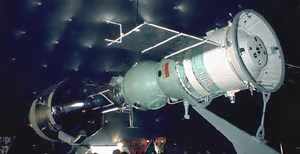
© Image: J W Hodges
The first major international collaboration in space was the Apollo-Soyuz Mission. The Mission took place between 15 July and 2 August 1975. The Apollo module had been scheduled for use on the cancelled Apollo 18 Mission to the Moon. It was launced on a Saturn 1B and linked to a Soyuz craft from the Soviet Union (now Russia).
The linking of the two ships was symbolic in many ways. Not only did the mission form the first international space station, it was a gesture of friendship and co-operation that has endured ever since.
From the technical point of view, a significant milestone was reached too. Before this time Soviet (Russian) and American spacecraft used different docking systems. The Apollo and the Soyuz were able to link using a specially designed tunnel with an American docking ring one end and a Russian one the other. Since that time, though, a standard docking system has developed, that all nations involved in manned space exploration use.
Go to Links page

Skylab
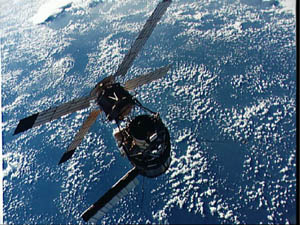
The only all-American space station was Skylab. The Skylab itself was launched on a Saturn 5 on 14 May 1973. It was unmanned at first, but the launch counted as Skylab 1. Skylab 2 was the first manned mission. Three crew were launched in an Apollo module on a Saturn 1B on 25 May and it landed on 22 June 1973. The station itself remained in space, of course and further missions quickly followed.
Skylab 3 began on 28 July and landed on 25 September that year. It was crewed by Alan Bean, Jack Lousma and Owen Garriott. The mission lasted just over 59 days. Skylab 4 followed on 16 November and lasted till February the following year, 84 days in all. The crew were Gerald Carr, William Pogue and Edward Gibson.
The Skylab space station itself was made fom the upper stage of a Saturn 5, known as an S4B. It was big for its era. When laden its mass was something close to 100,000 kg (200,000 lb).
Skylab eventually crashed to Earth on 11 July 1979, scattering debris across Australia, much to the annoyance of the local population.
Skylab provided information that was very helpful in understanding how to live and work in space. Its experimental results are stll being looked at, more than twenty years later.
Skylab Archive
Go to Links page
© Image: NASA

Spacelab
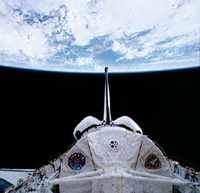 Spacelab was not a true space station, for it was built to remain in the cargobay of a Shuttle Orbiter. It is notable however, because it was the the first major manned venture by the European Space Agency. It carried out general research in space, and stayed in orbit for a significant time. Spacelab was jointly developed between NASA and ESA Spacelab was not a true space station, for it was built to remain in the cargobay of a Shuttle Orbiter. It is notable however, because it was the the first major manned venture by the European Space Agency. It carried out general research in space, and stayed in orbit for a significant time. Spacelab was jointly developed between NASA and ESA
This image shows Spacelab in the Shuttle Orbiter cargobay. It is Mission STS-40 with the Spacelab Life Science 1.
More inforation is at Space Life Science Data Archive.
Go to Links page
© Image: NASA

Mir
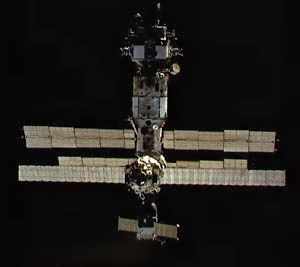 The Mir space station replaced the Salyut series of stations. It was launched in Feb 1986. Over the following months and years additional modules were added to the core. Originally it was an all-Soviet (Russian) venture, but NASA, ESA and many other world space agencies became involved, with NASA astronauts visiting and working on the station between March 1995 and May 1998. The Mir space station replaced the Salyut series of stations. It was launched in Feb 1986. Over the following months and years additional modules were added to the core. Originally it was an all-Soviet (Russian) venture, but NASA, ESA and many other world space agencies became involved, with NASA astronauts visiting and working on the station between March 1995 and May 1998.
Cosmonauts and astronauts from many countries visited the station until it ceased operations. The trials and tribulations of the Mir Space Station are legendary. When the Soviet Union broke up one cosmonaut was abandonned for months, alone on the station, until a replacement crew arrived.
Another incident occurred on 24/25 June 1997, when a Progess supply module collided with the solar panels and Spektr science module, puncturing the station and putting the crew into danger. Only the professionalism of the crew, which included the Anglo-American astronaut Michael Foale and Russians, Aleksandr Lazutkin and Commander Vasily Tsibliyev saved the day. However, it was Commander Tsibliyev's unnecessary action in trying to manually dock the Progress that caused the incident. Mir was finally abandoned by its crew on the 27th of August 1999.
More information is at Mir Information from NASA.
Go to Links page
© Image: NASA/RSA

ISS The International Space Station
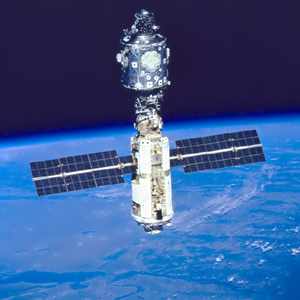 The first element of the ISS were launched by an Energia heavy lift launch vehicle on November 1998. Additional modules were added by the Shuttle Orbiter in the following months. The station is due to be crewed for the first time after the turn of the millennium. This image was taken during June1999, during STS 96 over the Hulun Nur lake in China. Further modules will be added in November and December 1999. The first element of the ISS were launched by an Energia heavy lift launch vehicle on November 1998. Additional modules were added by the Shuttle Orbiter in the following months. The station is due to be crewed for the first time after the turn of the millennium. This image was taken during June1999, during STS 96 over the Hulun Nur lake in China. Further modules will be added in November and December 1999.
Eventually the assembled station will be like this:
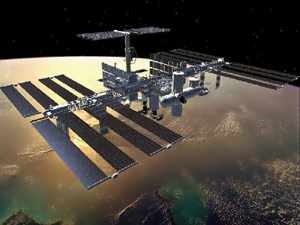
© Image: NASA
More information is at NASA Human Spaceflight Mainpage.
Go to Links page

Go to Links page
Return
|













